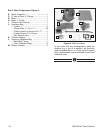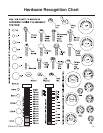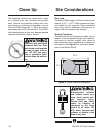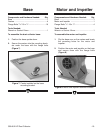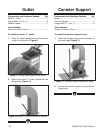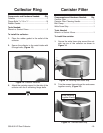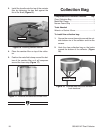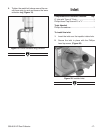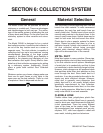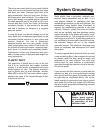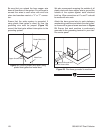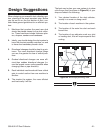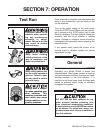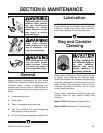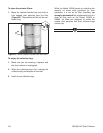
-18- G0548 2 HP Dust Collector
You have many choices regarding main line and
branch line duct material. In most commercial
workshops, the main line and branch lines are
usually metal duct. Flexible hose is then used to
connect each machine to the branch lines. In the
case of small home shops, flexible hose may be
used for both main line and branch line ducts.
Plastic duct is also a popular material for home
shops. Please be aware that there is a fire or
explosion hazard if plastic duct material is used
for dust collection without being grounded
against static electrical charge build-up. This
topic will be discussed later in the manual.
METAL DUCT
Metal duct comes in many varieties. Stove pipe,
heating/ventilation duct and duct made especial-
ly for dust collection are all options. Advantages
of metal duct is its conductivity and that it does
not contribute to static electrical charge build-up.
However, static charges are still produced when
dust particles strike other dust particles as they
move through the duct. Since metal duct is a
conductor, it can be grounded quite easily to dis-
sipate any static electrical charges. However,
metal duct is generally more expensive than
plastic duct and it is not usually airtight unless
specifically manufactured for dust collection.
Specially manufactured metal duct, on the other
hand, is quite expensive. Metal duct is also gen-
erally more difficult to cut and assemble.
FLEXIBLE HOSE
Flexible rubber hose, polyethylene, plastic flex-
hose and other flexible ribbed hose is generally
used for short runs, small shops and at rigid duct-
to-tool connections. There are many different
types of flex hose on the market today. These
are manufactured from materials such as poly-
ethylene, PVC, cloth hose dipped in rubber and
even metal, including steel and aluminum.
The Model G0548 can be operated as either a
stationary or a mobile unit. There are advantages
and disadvantages to both set-ups. The advan-
tage of the mobile system is eliminating the cost
of many ducts and fittings. On the other hand, the
stationary system is more versatile and conve-
nient.
The Model G0548 is designed to be a central
dust collector system. Locate the dust collector in
an out of the way location such as a corner or
separate room. The dust collector is capable of
collecting dust from up to two machines running
simultaneously. Because of the large suction
capacity of the Model G0548, great flexibility is
possible in the planning and designing of your
dust collection duct layout. Grizzly offers a com-
plete line of dust collection accessories for setting
up a stationary system. Additionally, Grizzly
offers a guide book entitled Dust Collection
Basics.
Whatever system you choose, always make sure
there are no open flames or pilot lights in the
same room as the dust collector. There is a risk
of explosion if dust is dispersed into the air.
Material Selection
General
SECTION 6: COLLECTION SYSTEM



